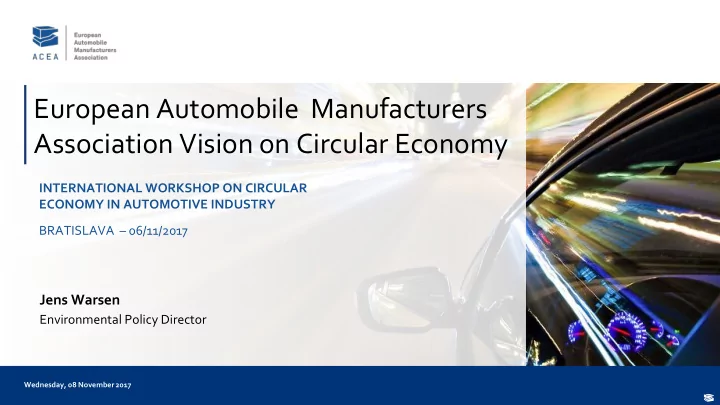

European Automobile Manufacturers Association Vision on Circular Economy INTERNATIONAL WORKSHOP ON CIRCULAR ECONOMY IN AUTOMOTIVE INDUSTRY BRATISLAVA – 06/11/2017 Jens Warsen Environmental Policy Director Wednesday, 08 November 2017
ACEA MEMBERS
KEY POINTS OF THE CIRCULAR ECONOMY CONCEPT from an Automotive perspective The Automotive Industry is committed to Circular Economy since many years • Optimizing production processes and use phase of vehicles – life-cycle • Keeping products in the life-cycle – waste prevention o Longevity and repairability of products o Remanufacturing, reusability (e.g. large and complex parts like engines & gear-boxes) • Supporting re-use and recycling o Improving quality of recyclates by complying with REACH legislation o High recycling quota on product level (85%) o No more abandoned End of Life Vehicles (ELV) 3
RECYCLING OF WASTE STREAMS ≠ • „Simple“ product • One of the most „complex“ consumer products • Few different materials • Very many different materials • Short span of life - only one “owner” • Long life span - several different owners • Recycling Quota ~ 55% • Recycling Quota ~ 85% 4
EUROPEAN WASTE REGULATION Resource Strategy Recycling Strategy Waste Oil Directive Landfill- Directive on Waste Directive Horizontal Thermal legislation Sector Specific Regulation Treatment affecting ELV of Waste Shipment ELV- WEEE- Battery- of Waste Directive Directive Directive POP regulation ELV = End-of-Life Vehicles WEEE = Waste Electrical and Electronic Equipment POP = Persistent Organic Pollutant 5
ELV DIRECTIVE -FITNESS CHECK 2014 Findings of the fitness-check • ELV Directive has proven to be effective and provides a significant contribution to environmental protection • Good progress towards achieving the objectives and targets have been confirmed • Concluded that ELV directive remains up-to date with current needs • Broad coherence with other EU waste legislations was identified with some room for formal alignment with Waste-Framework-Directive (WFD) • Lack of reliability and comparability of statistics (Member-States) + formal alignment with WFD 6
ELV-DIRECTIVE -SHARED RESPONSIBILITY Shared responsibilities of all economic operators Treatment Government/ Manufacturers and Last owner Operators Authorities Importers Licence shredder Take back ELVs Take back network and dismantlers Environmentally Substance restrictions Enforce standards sound treatment Deliver ELV at requirements for ELV treatment take back site Achievement and Dismantling information Install registration- Vehicle is monitoring of the Design for sustainability complete and recycling- and and deregistration Confirmation of recyclability/ free of waste recovery quotas system recoverability prevent illegality 7
C O D – KEY FOR SUCCESS Vehicle owner Temporary deregistration - tax/insurance (max. 1 year, no automatic deletion of vehicles from register) for registered vehicle until deregistration via direct debit Sales contract Sale authorisation from bank account Final Deregistration at (high penalties, certified treatment CoD* if tax not paid) facility Deregistration only with sales contract or CoD No other documents allowed (CoA**, NoD***) (* Certificate of Destruction ** Certificate of Acceptance, *** Notification of Destruction) Issuing a CoD = classification as ELV Raise customer awareness regarding importance of CoD as basis for deregistration 8
REMAINING CHALLENGES • Increasing number of substance-regulations: ELV, POPs Regulation / Stockholm Convention, REACH… • More stringent thresholds for substances in recycled materials (POP regulation, REACH) • Potential contradiction with existing recycling targets (e.g. ELV Directive) and the strategic targets of the Circular Economy activities • Overlapping regulations: complete vehicles vs components (e.g. EU ELV and Battery Directive) • Recognizing recycling as a tool: minimum recycled material targets for a material or product are not appropriate • Lack of global alignment (China, EU, Canada, Korea, Taiwan ROHS; China, Korea, EU ELV…) 9
CONCLUSION • Existing EU legislation provides a framework that already has the potential to foster a circular economy • ELV-Directive has proven highly effective in preventing waste disposal, increasing re-use, recycling and recovery, as well as ensuring treatment of ELVs in an environmental sound way • However, further improvement is needed for o Enforcement of existing legislation in all MS in order to create a level playing field in the ELV recycling business o Mandatory Registration/De-registration system with compulsory CoD in order to demonstrate proper ELV treatment and support monitoring o Avoidance of contradicting targets from overlapping legislation • The automotive industry is committed to implement the right measures at hand and to apply these on base of a free adaption within the legal framework 10
THANK YOU FOR YOUR ATTENTION @ACEA_eu www.acea.be
Recommend
More recommend